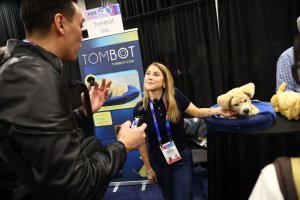NEW YORK, Jan. 10 (UPI) — Emotional support dogs can serve people with various mental health needs, but many of them can’t care for an animal at home.
That’s where Tombot Inc. feels it can help. The company, based in Santa Clarita, Calif., has designed a robotic puppy to aid individuals, families and communities in dealing with health adversities.
This week, Tombot unveiled “Jennie,” its battery-operated yellow Labrador retriever puppy at the International CES — formerly known as the Consumer Electronics Show — in Las Vegas. More than 15,000 people flocked to the annual trade show, often billed as the world’s most powerful tech event, which ends Friday.
The futuristic Jennie is intended to provide emotional support and mental health care for people with dementia, mild cognitive impairment, autism, anxiety, post-traumatic stress disorder and other conditions, the company says.
“It’s designed to accurately emulate an 8-to-10-week-old Labrador retriever puppy, so it has authentic Labrador retriever sounds,” Tombot CEO Tom Stevens told UPI.
The sounds are from actual recordings of dogs barking, whining, howling, cooing and snoring. And the puppy can open and close its mouth and eyes, move its head and neck, and wag its tail.
Meanwhile a sensory system allows the puppy to “tell the difference between a simple touch, a slow caress, a vigorous pet and being held,” Stevens said.
In addition, “she responds to a very long list of voice commands, but only to her name,” he said. By using a smartphone app, a user can give the robot any name.
Stevens got the inspiration to create the puppy from his mother, Nancy, who became very upset that he had to take her dog away for safety reasons after her diagnosis of Alzheimer’s disease.
“The journey to launching Tombot began as a journey to solve my mother’s problem,” Stevens said. “Only later did I realize her story is shared by more than 300 million seniors with dementia or pre-dementia mild cognitive impairment.”
Along with a team of contract engineers, Tombot handles all aspects of design. A manufacturing partner will oversee part fabrication and final assembly, Stevens said.
The puppy is in the final Alpha pre-production stage. Soon it will be in the Beta stage. Then Tombot will resume accepting pre-orders later this year at a cost of $1,500 per puppy.
“We have over 8,000 pre-order and waitlist customers, including more than 200 B2B customers — hospitals, skilled nursing, assisted living and memory care facilities – coming from 86 countries,” Stevens said.
The company’s co-founder, Hank Schorz, is the chief technical officer. “Being that we’re still rather small — and getting bigger — I do many technical things,” he said. “We all wear many hats at Tombot. I designed the overall concepts used in Jennie — our first robotic dog.”
Marissa Steingold, an account executive at the company, said Tombot has tested its prototypes on more than 700 seniors with dementia in the Los Angeles area.
“So, we are confident that this patient population will love Jennie,” Steingold said. “Many other patient populations have reached out, such as those with anxiety, PTSD, major depressive disorder, autism, mobility challenges and suicide risk.”
The company is engaged in development on at least 17 studies with a variety of patient populations, including children’s hospitals, she said.
Pets robots are an innovative technology that has demonstrated a positive influence on improving mood, reducing agitation and anxiety, and promoting social interactions, said Wei Qi Koh, a lecturer in occupational therapy at The University of Queensland in Brisbane, Australia, who has researched this phenomenon.
“They appear to provide some form of companionship to older adults and people with dementia, and provide them with opportunities to engage in activities, such as naming the pet, holding or brushing it or taking it to places,” Koh said.
But a robotic cat or dog may not be an effective tool if an individual has never owned a pet or isn’t an animal lover, said Elizabeth Edgerly, senior director of community programs and services at the Alzheimer’s Association in Chicago.
Robots or other stimuli “are no substitute for a human relationship,” Edgerly said. “They are complementary tools that can be used in conjunction with human interaction. For example, you may use a robotic pet to help engage the person in a conversation about pets they have had in their lives.”

COMMENTS
Please let us know if you're having issues with commenting.